What Were The Main Goods And Services The United States Traded Internationally In The 1990s

Average tariff rates (France, Great britain, US)
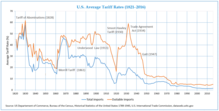
Boilerplate Tariff Rates in US (1821–2016)

Imports vs exports & net imports

Foreign trade of the United States comprises the international imports and exports of the United States. The country is amid the height 3 global importers and exporters.

Trade exports (1870–1992)
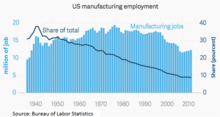
U.s.a. manufacturing employment
The regulation of merchandise is constitutionally vested in the United states of america Congress. Afterwards the Great Depression, the country emerged as amidst the well-nigh significant global merchandise policy-makers, and information technology is now a partner to a number of international merchandise agreements, including the General Understanding on Tariffs and Trade (GATT) and the Earth Trade Organization (WTO). Gross U.South. avails held by foreigners were $16.3 trillion as of the end of 2006 (over 100% of Gdp).
Introduction [edit]
The country has trade relations with many other countries. Within that, the trade with Europe and Asia is predominant. To fulfill the demands of the industrial sector, the country has to import mineral oil and fe ore on a big scale. Machinery, cotton wool yarn, toys, mineral oil, lubricants, steel, tea, sugar, coffee, and many more items are traded. The country's export listing includes food grains similar wheat, corn, and soybean. Airplane, cars, computers, paper, and machine tools required for unlike industries. In 2016 U.s.a. electric current business relationship residual was −$469,400,000,000.[ii] Us manufacturers exported $i,365.31 billion in goods exports in 2019,with Canada, United mexican states, Red china, Japan and the United kingdom of great britain and northern ireland representing 35.44% of the consign market.[3]
Relatively few US companies consign; a 2009 study reported that eighteen% of United states manufacturers export their appurtenances. Exporting is full-bodied to a small number of companies: the largest 1% of Us companies that export contain 81% of US exports.[4]
History [edit]
The potency of Congress to regulate international merchandise is set up out in the United states Constitution (Article I, Department viii, Paragraph 1):
The Congress shall have power To lay and collect Taxes, Duties, Imposts and Excises, to pay the Debts and provide for the common Defence and to promote the general Welfare of the United States; but all Duties, Imposts and Excises shall be uniform throughout the United States
Congressional authority over international trade includes the power to impose tariffs and to found tariff rates; implementing merchandise agreements; providing remedies confronting unfairly traded imports; controlling the export of sensitive engineering and extending tariff preferences to imports from developing countries. Over time, and nether carefully prescribed circumstances, Congress has delegated some of its trade authority to the Executive Co-operative. Congress, all the same, has, in some cases, kept tight reins on the use of this authority past requiring that certain trade laws and programs exist renewed; and by requiring the Executive Co-operative to issue reports to Congress so the latter can monitor the implementation of the trade laws and programs.[5]The Embargo Human action of 1807 was designed to force Britain to rescind its restrictions on American trade, just failed, and was repealed in early 1809.
During the Civil War, leaders of the Confederacy were confident that Britain would come to their aid because of British reliance on Southern cotton.[six] The Union was able to avoid this, through skillful utilise of diplomacy and threats to other aspects of European-U.S. merchandise relations.
Near the end of the Second World War U.S. policy makers began to experiment on a broader level. In the 1940s, working with the British regime, the Us developed two innovations to expand and govern merchandise among nations: the General Understanding on Tariffs and Trade (GATT) and the International Merchandise Organization (ITO). GATT was a temporary multilateral understanding designed to provide a framework of rules and a forum to negotiate trade bulwark reductions among nations.
The growing importance of international trade led to the establishment of the Office of the U.S. Trade Representative in 1963 past Executive Order 11075, originally called The Office of the Special Representative for Trade Negotiations.[7]
Trade policy [edit]
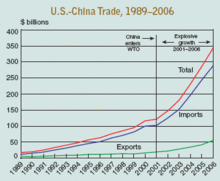
United States trade policy has varied widely through various American historical and industrial periods. As a major developed nation, the U.S. has relied heavily on the import of raw materials and the export of finished goods. Because of the significance for American economy and industry, much weight has been placed on trade policy by elected officials and business leaders.[viii] [9]
International trade also influences the U.Southward. presidential election since voters' exposure to trade influences who wins the US presidency, according to Usa Demography data covering nearly all economic activeness in the Us. Moreover, employees in high-wage tradable goods and services sectors are more than likely to back up incumbent presidents and their parties, whereas those in low-wage manufacturing jobs will be more likely to support the opposition.[x]
The 1920s marked a decade of economic growth in the United States following a Classical supply side policy.[11] U.S. President Warren Harding signed the Emergency Tariff of 1921 and the Fordney–McCumber Tariff of 1922. Harding's policies reduced taxes and protected U.South. business and agronomics.[12] Following the Great Low and Earth War Two, the United Nations Monetary and Fiscal Briefing brought the Bretton Woods currency agreement followed by the economy of the 1950s and 1960s. In 1971, President Richard Nixon concluded U.South. ties to Bretton Forest, leaving the U.S. with a floating fiat currency. The stagflation of the 1970s saw a U.S. economy characterized past slower GDP growth. In 1988, the The states ranked first in the globe in the Economist Intelligence Unit "quality of life alphabetize" and third in the Economical Freedom of the World Index.[xiii]
Over the long run, nations with trade surpluses tend also to accept a savings surplus. The U.Due south. generally has developed lower savings rates than its trading partners, which take tended to have merchandise surpluses. Germany, France, Japan, and Canada have maintained higher savings rates than the U.S. over the long run.[14]
Some economists believe that GDP and employment tin be dragged down by an over-large deficit over the long run.[15] Others believe that trade deficits are good for the economy.[16] The opportunity cost of a forgone taxation base may outweigh perceived gains, especially where bogus currency pegs and manipulations are present to distort trade.[17]
In 2006, the primary economic concerns focused on: loftier national debt ($9 trillion), high non-bank corporate debt ($9 trillion), high mortgage debt ($9 trillion), high financial institution debt ($12 trillion), high unfunded Medicare liability ($30 trillion), high unfunded Social Security liability ($12 trillion), high external debt (corporeality owed to foreign lenders) and a serious deterioration in the U.s. net international investment position (NIIP) (−24% of GDP),[ane] high trade deficits, and a rise in illegal immigration.[xviii] [19]
These issues have raised concerns among economists and unfunded liabilities were mentioned every bit a serious problem facing the United States in the President's 2006 State of the Union address.[19] [xx] On June 26, 2009, Jeff Immelt, the CEO of General Electric, called for the U.South. to increment its manufacturing base employment to 20% of the workforce, commenting that the U.S. has outsourced also much in some areas and can no longer rely on the financial sector and consumer spending to drive demand.[21]
In 1985, the U.S. had just begun a growing trade deficit with China. During the 1990s, the U.S. merchandise deficit became a more than excessive long-run trade deficit, mostly with Asia. By 2012, the U.S. trade deficit, financial budget deficit, and federal debt increased to record or near-record levels following the implementation of broad unconditional or unilateral U.S. complimentary merchandise policies and formal merchandise agreements in the preceding decades.[22] [23]
The US last had a trade surplus in 1975.[24] However, recessions may cause brusque-run anomalies to ascension merchandise deficits. [ clarify ]
The rest of trade in the Us has been a concern amongst economists and business people. Warren Buffett, founder of Berkshire Hathaway, was quoted in the Associated Press (January 20, 2006) equally saying "The U.South. trade deficit is a bigger threat to the domestic economy than either the federal budget deficit or consumer debt and could lead to political turmoil... Right now, the rest of the globe owns $three trillion more of united states than we ain of them."
In both a 1987 guest editorial to the Omaha-Globe Herald and a more detailed 2003 Fortune commodity, Buffett proposed a tool called Import Certificates as a solution to the United states' problem and ensure balanced trade. "The remainder of the world owns a staggering $2.5 trillion more of the U.Due south. than nosotros own of other countries. Some of this $2.five trillion is invested in merits checks—U.S. bonds, both governmental and private—and some in such assets as holding and equity securities."[25]
In 2013 the U.s.a.' largest trading partner was Canada.[26] Red china has seen substantial economic growth in the past fifty years[ when? ] and though a nuclear-security summit that took place in early 2010 President Obama hoped to ensure another 50 years of growth between the two countries. On April 19, 2010, President Obama met with China's President Hu Jintao to hash out trade policies between the two countries.[ citation needed ]
Though the US merchandise deficit has been stubborn, and tends to be the largest past dollar volume of whatsoever nation, even the most extreme months as measured by percent of Gdp there are nations that are far more noteworthy. Case in point, post 2015 Nepal earthquake, Nepal's merchandise gap (in goods & services) was a shocking 33.3% of Gross domestic product[27] although heavy remittances considerably offset that number. Co-ordinate to the US Department of Commerce Bureau of Economic Analysis (BEA), January 27, 2017 report, the Gross domestic product "increased 4.0 percent, or $185.5 billion, in the fourth quarter of 2016 to a level of $18,860.8 billion."[28]
In 2018, the year that a trade war with People's republic of china was launched by U.Southward. President Donald Trump, the U.Southward. trade deficit in goods reached $891 billion, the largest on record.[29]
Customs territory [edit]
The main customs territory of the U.s.a. includes the 50 states, the District of Columbia, and the territory of Puerto Rico, with the exception of over 200 foreign trade zones designated to encourage economic activeness. People and goods entering this territory are subject to inspection past U.S. Community and Edge Protection. The remaining insular areas are separate customs territories administered largely by local regime:
- American Samoa
- Guam
- Northern Mariana Islands
- United states of america Modest Outlying Islands (mostly uninhabited)
- U.s.a. Virgin Islands
Transportation of certain living things or agronomical products may be prohibited even within a customs territory. This is enforced past U.South. Customs and Border Protection, the federal Brute and Found Health Inspection Service, and even state government such as the California Department of Food and Agriculture.
Investment in the United states of america [edit]
Gross U.S. assets held by foreigners were $16.3 trillion as of the end of 2006 (over 100% of Gdp). The U.South. net international investment position (NIIP) [30] became a negative $two.five trillion at the stop of 2006, or about minus 19% of Gdp.[ane] [31]
This effigy rises every bit long as the U.Due south. maintains an imbalance in merchandise, when the value of imports essentially outweighs the value of exports. This external debt does not result mostly from loans to Americans or the American government, nor is it consumer debt owed to non-U.S. creditors. It is an accounting entry that largely represents U.S. domestic avails purchased with trade dollars and owned overseas, largely past U.S. trading partners.[32]
For countries similar the U.s., a large internet external debt is created when the value of strange avails (debt and equity) held past domestic residents is less than the value of domestic avails held by foreigners. In simple terms, as foreigners buy belongings in the U.Due south., this adds to the external debt. When this occurs in greater amounts than Americans ownership belongings overseas, nations like the United States are said to be debtor nations, only this is not conventional debt like a loan obtained from a banking concern.[1] [30]

Account balance as of 2006[33]
If the external debt represents foreign ownership of domestic assets, the result is that rental income, stock dividends, upper-case letter gains and other investment income is received by strange investors, rather than by U.S. residents. On the other hand, when American debt is held by overseas investors, they receive interest and primary repayments. As the trade imbalance puts extra dollars in hands outside of the U.South., these dollars may be used to invest in new avails (foreign direct investment, such as new plants) or exist used to buy existing American avails such every bit stocks, real manor and bonds. With a mounting trade deficit, the income from these assets increasingly transfers overseas.[1] [xxx]
Of major concern is the magnitude of the NIIP (or net external debt), which is larger than those of most national economies. Fueled past the sizable trade deficit, the external debt is and so large that economists are concerned over whether the current account deficit is unsustainable. A complicating factor is that trading partners such every bit Red china, depend for much of their economy on exports, especially to America. There are many controversies about the current trade and external debt situation, and it is arguable whether anyone understands how these dynamics volition play out in a historically unprecedented floating exchange rate system. While various aspects of the U.S. economic contour have precedents in the situations of other countries (notably government debt equally a percentage of GDP), the sheer size of the U.South., and the integral role of the U.Southward. economy in the overall global economic environment, create considerable uncertainty near the future.[1] [30]
According to economists such as Larry Summers and Paul Krugman, the enormous arrival of uppercase from China is i of the causes of the global financial crisis of 2008–2009. Red china had been buying huge quantities of dollar assets to keep its currency value low and its export economy humming, which acquired American interest rates and saving rates to remain artificially depression. These low involvement rates, in turn, contributed to the United states housing bubble because when mortgages are cheap, firm prices are inflated every bit people tin beget to infringe more.[34] [35]
Trade agreements [edit]

Usa
Free-merchandise areas
The United states of america is a partner to many trade agreements, shown in the chart below and the map to the right.
The United states of america has likewise negotiated many Trade and Investment Framework Agreements, which are oft precursors to free trade agreements. Information technology has also negotiated many bilateral investment treaties, which concern the movement of capital rather than appurtenances.
The U.S. is a member of several international trade organizations. The purpose of joining these organizations is to come up to agreement with other nations on trade problems, although there is domestic political controversy to whether or not the U.S. government should be making these trade agreements in the start place. These organizations include:
- Globe Trade Organisation
- Organization of American States
- Security and Prosperity Partnership of North America
Every bit of 26 Feb 2022, The U.s.a. has barred about Russian imports including (semiconductors, lasers, liquor, computers) etc. due to the 2022 Russian-Ukraine State of war. This is the biggest bar on imports in the U.S. since WWll. The U.S. and Canada partnered on the ban of liquor and food stuff on 25, February 2022 after it was announced that Russian troops had taken Chernobyl nuclear power plant.
Internal institutions [edit]
American strange merchandise is regulated internally past:
- United States Court of International Merchandise
- U.s. International Trade Commission
Imports and exports [edit]
-

Proportion of United states exports to imports 1960–2004
-
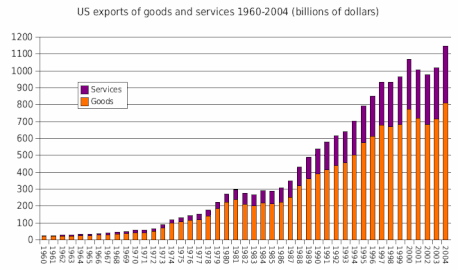
The states exports of goods and services 1960–2004
-
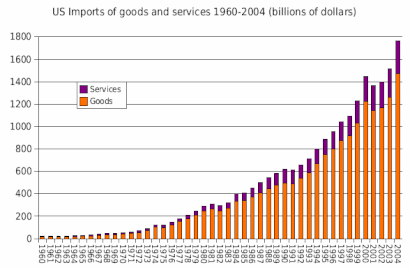
US imports of goods and services 1960–2004
-

U.s.a. exported $1.44 trillion to other countries in 2014
-

United states of america exports of goods by land in 2004 (does not include exports of services)
-

U.s. imports of goods by country in 2004 (does not include imports of services)
-
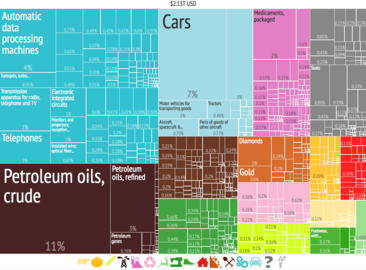
U.s.a. imported $2.13 trillion from other countries in 2014
Run into as well [edit]
- Federal Trade Commission Act
- Merchandise Act of 2002
- Trading with the Enemy Act 1917
- Trade wars
- Tariff in American history
- Mergers
- United States balance of trade
References [edit]
- ^ a b c d e f Bivens, Fifty. Josh (Dec 14, 2004). Debt and the dollar Archived Dec 17, 2004, at the Wayback Car Economic Policy Institute. Retrieved on July 8, 2007.
- ^ "The World Factbook — Central Intelligence Bureau". Cia.gov. Archived from the original on 2 June 2010. Retrieved 4 October 2017.
- ^ "2020 United States Manufacturing Facts". NAM . Retrieved 2022-03-03 .
- ^ Kim, In Song; Osgood, Iain (2019-05-11). "Firms in Merchandise and Merchandise Politics". Almanac Review of Political Scientific discipline. 22 (1): 399–417. doi:10.1146/annurev-polisci-050317-063728. ISSN 1094-2939.
- ^ Bolle, Mary Jane (2007-x-02). "U.S. Merchandise Statutes: Expiration Dates and Mandated Periodic Reports to Congress" (PDF) . Retrieved 2008-07-24 . This commodity incorporates text from this source, which is in the public domain.
- ^ U.S. Department of Country, Office of the Historian Preventing Diplomatic Recognition of the Confederacy
- ^ International Merchandise and Investment art S. Fisher and Michael P. Malloy
- ^ "World Business concern Leaders Urge Trade Ministers To Seize The Opportunity to Resurrect the Doha Round – Trade Resource Center – Business concern Roundtable". 3 January 2006. Archived from the original on 3 Jan 2006. Retrieved fifteen March 2018.
- ^ Akhtar, Shayerah Ilias (November i, 2018). U.S. Trade Policy Functions: Who Does What? (PDF). Washington, DC: Congressional Research Service. Retrieved 11 November 2018.
- ^ Jensen, J. Bradford; Quinn, Dennis; Weymouth, Stephen (January 2016). "Winners and Losers in International Trade: The Effects on U.South. Presidential Voting": w21899. doi:x.3386/w21899.
- ^ Joseph A. Schumpeter, "The Decade of the Twenties", American Economic Review vol. 36, No. 2, (May, 1946), pp. 1–10 in JSTOR
- ^ "The Harding/Coolidge Prosperity of the 1920s". Calvin-coolidge.org. Archived from the original on 2009-03-12. Retrieved 2009-03-30 .
- ^ Star Parker (Dec 17, 2012).Tea Partiers must hang tough.Urbancure.com
- ^ "The shift away from thrift". The Economist, April vii, 2005.
- ^ Causes and Consequences of the Trade Deficit: An Overview Archived March 15, 2008, at the Wayback Machine
- ^ "Growing Trade Deficit Good News for U.Southward. Economy". Web log.heritage.org . Retrieved 4 Oct 2017.
- ^ Bivens, Josh (September 25, 2006 ).China Manipulates Its Currency – A Response is Needed. Economical Policy Institute. Retrieved on February 2, 2010.
- ^ Phillips, Kevin (2007). Bad Coin: Reckless Finance, Failed Politics, and the Global Crisis of American Capitalism. Penguin. ISBN978-0-14-314328-four.
- ^ a b Cauchon, Dennis and John Waggoner (Oct 3, 2004). The Looming National Benefit Crisis United states of america Today
- ^ George W. Bush (2006) State of the Wedlock. Retrieved on April 17, 2009. Archived November 23, 2009, at the Wayback Machine
- ^ Bailey, David and Soyoung Kim (June 26, 2009).GE's Immelt says U.S. economic system needs industrial renewal. UK Guardian.. Retrieved on June 28, 2009. Archived August 15, 2009, at the Wayback Machine
- ^ "U.S. Trade in Goods and Services – Balance of Payments, 1960 through 2014". Census.gov . Retrieved Oct 4, 2017.
- ^ "FTD – Statistics – Country Information – U.S. Trade Balance with World (Seasonally Adjusted)". Demography.gov . Retrieved October 4, 2017.
- ^ "Archived re-create". Archived from the original on 2013-05-17. Retrieved 2013-02-04 .
{{cite web}}: CS1 maint: archived copy as championship (link) - ^ America'south Growing Trade Deficit Archived 2014-04-09 at the Wayback Machine Warren East. Buffett
- ^ Sectionalization, US Demography Agency Foreign Trade. "Foreign Trade: Information". Census.gov . Retrieved October 4, 2017.
- ^ "Nepal's trade deficit soars to 33.34 percent of Gdp". Kathmandupost.ekantipur.com . Retrieved 4 October 2017.
- ^ Bureau of Economical Analysis (BEA) (January 27, 2017), "National Income and Product Accounts : Gross Domestic Product: Fourth Quarter and Annual 2016 (Advance Approximate)", US Department of Commerce , retrieved February 24, 2017
- ^ Politti, James; Rocco, Matthew (March half dozen, 2019). "Blow to Trump as US trade deficit hits 10-twelvemonth high". Financial Times. Retrieved March viii, 2019.
- ^ a b c d Chapter five–10: The International Investment Position. International Finance Theory and Policy. iii June 2004. Retrieved 17 Nov 2008.
- ^ "News Release: U.S. International Investment Position, 2006". BEA. June 28, 2007. Retrieved 2008-11-17 .
- ^ Bivens, 50. Josh (December 14, 2004). "Debt and the dollar: The United States damages future living standards past borrowing itself into a deceptively deep hole". Epinet.org. Archived from the original on January 20, 2008. Retrieved 2009-06-28 .
- ^ Current business relationship remainder, U.Southward. dollars, Billions from International Budgetary Fund Earth Economic Outlook Database, April 2008
- ^ "Reflections on Global Account Imbalances and Emerging Markets Reserve Accumulation". 9 May 2008. Archived from the original on 9 May 2008. Retrieved iv October 2017.
- ^ "The Unofficial Paul Krugman Web Page". Pkarchive.org . Retrieved 4 October 2017.
External links [edit]
- Comprehensive The states Trade Data
- US Exports/Imports Trade Balance
What Were The Main Goods And Services The United States Traded Internationally In The 1990s,
Source: https://en.wikipedia.org/wiki/Foreign_trade_of_the_United_States
Posted by: ramirezbispecephe60.blogspot.com


0 Response to "What Were The Main Goods And Services The United States Traded Internationally In The 1990s"
Post a Comment